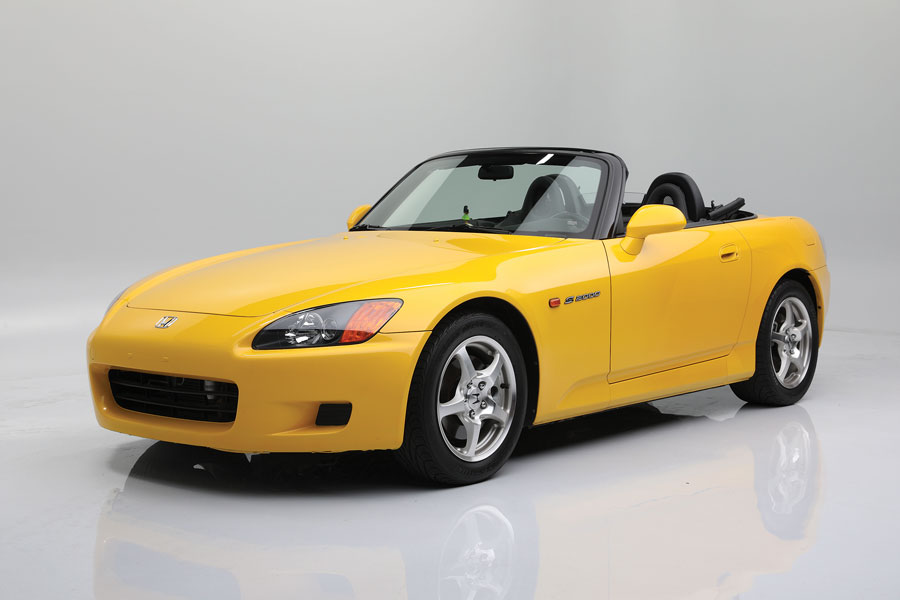
The Honda S2000 debuted in 1999, 10 years after Mazda’s Miata reinvigorated a sedentary roadster market in America. It offered more power than its topless German competitors (BMW Z3, Porsche Boxster, Mercedes-Benz SLK 320), along with a stiffer, more responsive chassis. It also undercut the competition with a $32,000 asking price at its debut for the 2000 model year. Best of all, it arrived when Honda’s quality and design were both at all-time highs.
It was, in other words, Honda’s segment killer.
A sports car for a new generation
The S2000’s 2.0-liter VTEC engine was legendary from the very beginning. At 120 horsepower per liter, the little Honda inline 4 made a higher specific output than Italian contemporaries such as the Ferrari F355. And at only about 2,800 pounds, the S2000 was also a lightweight. Car and Driver wrote, “Only four volume-production roadsters on sale in the U.S. can top the feather-weight S2000’s power-to-weight ratio: the Chevy Corvette, the Dodge Viper RT/10, the Ferrari F355 Spider, and the Plymouth Prowler.”
While being beaten in any contest by the Plymouth Prowler is nothing to be proud of, no one denied the remarkable feats of engineering under the S2000’s hood. Its impressive power was achieved through a dizzying rev limit. First-generation S2000s (known as AP1, after its official chassis designation) had an 8,800-rpm redline. They made 240 hp at 8,300 rpm, and 153 ft-lb of torque at 7,500 rpm. A 6-speed transmission was installed in every S2000, and a Torsen limited-slip differential was also standard.
Second-generation updates
The second-generation S2000 (AP2) showed up for the 2004 model year with a slightly larger engine and the promise of more refinement. Honda stroked the original F20 engine 6.7 mm, increasing displacement by 160 cc. (Thankfully the 2,157-cc roadster was not renamed “S2200.”) Peak power remained at 240 and torque increased only 8 ft-lb to 161. This grunt was delivered 1,000 rpm earlier, however, adding credence to Honda’s claims of improved drivability.
But it was the convertible’s handling that really changed for 2004. Front spring rates increased marginally while the rears fell slightly. The rear anti-roll bar was reduced in diameter and the steering ratio was slowed, effectively dulling the S2000’s razor-edged handling. The rear tires gained another 10 mm in width, further increasing their stagger relative to the fronts. Testers noted lower lateral grip, more understeer and better transitional stability.
Built for nailing apexes
The high-revving engine is the S2000’s defining character trait, for better or worse. Both generations demand a real commitment to high revs before they feel quick. Also, a healthy tolerance for engine noise.
Even exploiting the furthest reaches of the rev counter, they’re not stoplight terrors. Most tests put 0–60-mph times between six and seven seconds, though magazine test-drivers proved that a clutch-abusing 5.5-second run was possible. Quarter-mile times range from the mid-14s to the low 15s.
These cars were never meant for straight-line dogfights. Instead, the S2000 was an apex slicer, pure and simple. And when measured using that metric, it was a good one. The S2000’s hood slopes aggressively away from the cowl, and its front fenders stand proud of otherwise featureless flanks. This roadster has a high waistline and there’s plenty of legroom for six-footers. Even the second-gen cars with slower steering don’t feel particularly lazy when pointed into a corner.
Chassis stiffness was well beyond that of its period competition. With large door sills and a tall center tunnel that divides the passenger area, Honda claimed the S2000 had more bending rigidity than the Acura NSX Type S and the Integra Type R, both of which had fixed roofs. Honda called the raised tunnel the “high X-bone frame” and used it to connect the chassis’ front and rear structures.
On the uptick
Sales prices for all S2000s have climbed significantly in the past three years. In fact, pristine ultra-low-mile examples are garnering crazy money. Bring a Trailer is the highest-volume source of sales results for this model; in the last two years, some 13 S2000s listed there have sold for more than $40,000, with the top-earning cars bringing more than $70,000.
Keep an eye out for the bewinged CR or “Club Racer” trim, which offers stiffer springs and dampers, quicker steering, extra structural bracing, wider rear rubber on unique wheels, and a hard top. Honda sold 699 of them, which drives the price up higher than standard variants. Yet the bulk of the base-trim roadsters still transact for between $20,000 and $30,000, making them not only fun to drive, but also within reach for the everyman. ♦